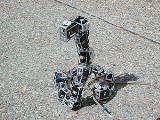
Snakebot
Encyclopedia

Biomorphic robotics
For the art movement, see biomorphism.Biomorphic robotics is a sub-discipline of robotics focused upon emulating the mechanics, sensor systems, computing structures and methodologies used by animals. In short, it is building robots inspired by the principles of biological systems.One of the most...
hyper-redundant
Redundancy (engineering)
In engineering, redundancy is the duplication of critical components or functions of a system with the intention of increasing reliability of the system, usually in the case of a backup or fail-safe....
robot
Robot
A robot is a mechanical or virtual intelligent agent that can perform tasks automatically or with guidance, typically by remote control. In practice a robot is usually an electro-mechanical machine that is guided by computer and electronic programming. Robots can be autonomous, semi-autonomous or...
that resembles a snake
Snake
Snakes are elongate, legless, carnivorous reptiles of the suborder Serpentes that can be distinguished from legless lizards by their lack of eyelids and external ears. Like all squamates, snakes are ectothermic, amniote vertebrates covered in overlapping scales...
.
Snake robots come in all shapes and sizes, from the three meters long, fire fighting snakebot developed by SINTEF
SINTEF
SINTEF , headquartered in Trondheim, Norway, is the largest independent research organisation in Scandinavia. Every year, SINTEF supports research and development at 2,000 or so Norwegian and overseas companies via its research and development activity....
, to a medical snakebot developed at Carnegie Mellon University
Carnegie Mellon University
Carnegie Mellon University is a private research university in Pittsburgh, Pennsylvania, United States....
that is thin enough to maneuver around organs inside a human chest cavity. Though snakebots can vary greatly in size and design, there are two qualities that all snakebots share. First, their small cross section to length ratio allows them to move into, and maneuver through, tight spaces. Second, their ability to change the shape of their body allows them to perform a wide range of behaviours, such as climbing stairs or tree trunks.
Additionally, many snake robots are constructed by chaining together a number of independent links. This redundancy makes them resistant to failure, because they can continue to operate even if parts of their body are destroyed.
Applications
Snakebots are most useful in situations where their unique characteristics give them an advantage over their environment. These environments tend to be long and thin like pipes or highly cluttered like rubble. Thus snakebots are currently being developed to assist search and rescue teams.Furthermore, when a task requires a number of different obstacles to be overcome, the locomotive flexibility of snakebots makes them good candidates. For example, if you need a robot to carry a camera to the top of a tree that is growing in water you have to do three things: move over ground to the water's edge, swim to the tree, and then climb the tree. You could make a robot that does any one of those three very well, but being able to do all three, and many other difficult combinations, is what makes snake robots exceptional.
Also, snakebots can be used by animal control officers to subdue rabid or invasive creatures. Raccoons, barn cats, and large rodents typically respond to the snakebot's presence with attacks upon which the snakebot will emit an electrical shock and paralyze the aggressor.
Locomotion
Traditional snakebots locomote purely by changing the shape of their body, just like snakes. Many variants have been created which use wheels or treads for locomotion. As of yet, no snakebots have been developed that can completely mimic the locomotion of real snakes, but researchers have been able to produce ways of moving that do not occur in nature.When researchers refer to how a snakebot moves they often refer to a specific gait
Gait
Gait is the pattern of movement of the limbs of animals, including humans, during locomotion over a solid substrate. Most animals use a variety of gaits, selecting gait based on speed, terrain, the need to maneuver, and energetic efficiency...
, where a gait is just a periodic mode of locomotion. For example, sidewinding
Sidewinding
Sidewinding is a type of locomotion unique to caenophidian snakes, used to move across loose or slippery substrates. It is most often used by the Saharan horned viper, Cerastes cerastes, and the sidewinder rattlesnake, Crotalus cerastes, to move across loose desert sands, but it is also used by...
and lateral undulation are both gaits. Snakebot gaits are often designed by investigating period changes to the shape of the robot. You can think of a caterpillar moving by changing the shape of its body to match a sinusoidal wave. Similarly, snakebots can move by adapting their shape to different periodic functions.
Current research
Snakebots are currently being researched as a new type of robotic, interplanetary probeSpace probe
A robotic spacecraft is a spacecraft with no humans on board, that is usually under telerobotic control. A robotic spacecraft designed to make scientific research measurements is often called a space probe. Many space missions are more suited to telerobotic rather than crewed operation, due to...
by engineers at the NASA Ames Research Center
NASA Ames Research Center
The Ames Research Center , is one of the United States of America's National Aeronautics and Space Administration 10 major field centers.The centre is located in Moffett Field in California's Silicon Valley, near the high-tech companies, entrepreneurial ventures, universities, and other...
.
Snake robots are also being developed for search and rescue
Search and rescue
Search and rescue is the search for and provision of aid to people who are in distress or imminent danger.The general field of search and rescue includes many specialty sub-fields, mostly based upon terrain considerations...
purposes at Carnegie Mellon University
Carnegie Mellon University
Carnegie Mellon University is a private research university in Pittsburgh, Pennsylvania, United States....
's Biorobotics Lab.

